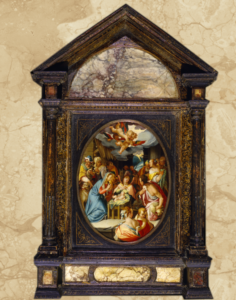You can enjoy other Christmas-themed works in M&G’s collection here.
You can enjoy other Christmas-themed works in M&G’s collection here.
Enjoy the following seasonal Scavenger Hunts to develop and exercise your observational skills! Each option references masterworks selected from M&G’s Collection.
Observers of all ages will not only discover exciting details in each painting or object, but also make connections between art and history.
View online OR print and study up close. As always, there is an Answer Key to check your finds!
Available February 17–April 19, 2025 (Monday-Saturday, 10AM-5PM)
To celebrate Easter, families are invited to begin at the Welcome Center for a campus search of special art objects related to the Easter story. This self-guided, informative activity (45-60 minutes long) is designed to captivate your child’s imagination and expose them to the life and times of Old Master painters. Return to the Welcome Center with your finished worksheet for a free prize!
This M&G activity is FREE!
We conclude our exploration of The Continuing Victorian Narrative with one of Dickens’ most beloved tales, A Christmas Carol.
To view the next video in the series about the Victorian era, click here.
Even in a digital age, we still love sending and receiving Christmas Cards, but what is the origin of this popular tradition?
To view the next video in the series about the Victorian era, click here.
Oil on panel
German, 1552-1615

At Christmas, our thoughts naturally turn to gifts. Given a choice, would you choose a large package or a small one? Perhaps it would be wise to remember the adage, “Good things come in small packages.” That sentiment is certainly true of M&G’s Object of the Month, a small painting (9.25” x 7”) that is like a precious jewel in a small gift box.
In addition to the Holy Family and the shepherds, the crowded scene includes women, another child, barn animals, the requisite angels tumbling from heaven, and a huge mastiff. Other innovative additions include bagpipes and a shovel. Far in the background the light of the angelic host can be seen illuminating the hillside. The painting is housed in a tabernacle-type frame with decorative gold tooling and stone insets. Tabernacle frames often held large pieces of art; this version captures the architectural features in miniature.
Aachen lived in Italy from 1574–1588, studying the great Italian masters, and in 1592 he became Court Painter to Holy Roman Emperor Rudolf II in Prague, a prestigious position that entailed diplomatic as well as artistic responsibilities. Rudolf was the greatest patron of the arts of his time, acquiring works by Dürer, Brueghel, and Veronese as well as works of contemporary northern Mannerist artists such as Aachen, Archimboldo, Spranger, and Savery.
The provenance, or history, of the painting can be traced to English ownership in 1834. English collectors of the nineteenth century amassed great quantities of art, much of it available because of wars and unrest in Europe. This work was part of an 1834 bequest to the Fitzwilliam Museum of Cambridge University; they retained ownership until 1959 when it was sold at Sotheby’s and acquired by the museum.
Anne Short, Former Research Supervisor
Published in 2013